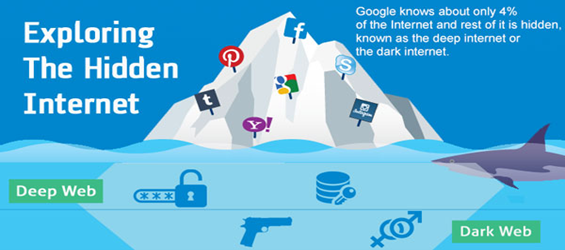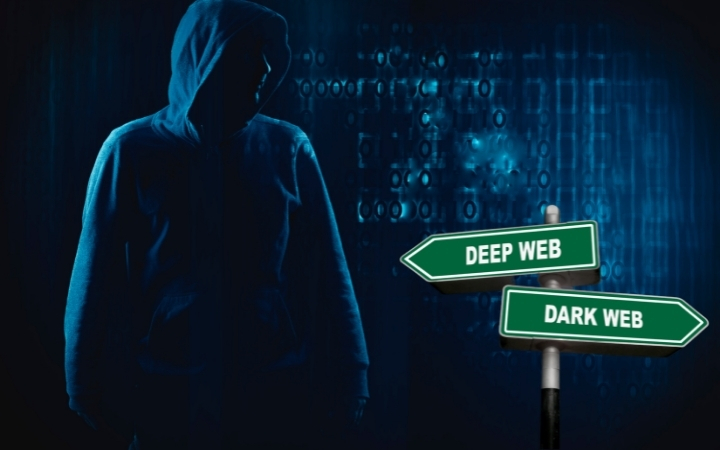What Is the Difference Between the Deep Web and the Dark Web?
“Deep web” and “dark web” are NOT interchangeable terms. Although the entire dark web is part of the deep web, it isn’t true in reverse. Simply put, the deep web is any part of the Net that is not indexed by search engines. This includes websites that gate their content behind paywalls, password-protected websites and even the contents of your email. The dark web, on the other hand, uses encryption software to provide even greater security.

What Is the Deep Web?
The “deep web” includes everything on the Net that is password protected, paywalled or even just protected from crawling by a site’s robots.txt file, which altogether account for anywhere between 96% and 99% of the content of the Net will never be found on any conventional search engine. For instance, when you log in to your favorite video streaming site or check your bank account balance online, that’s the deep web at work.
Deep Web: The deep web primarily consists of web pages and content that are not indexed or easily accessible through traditional search engines. It includes a vast amount of information, databases, and resources that are not meant to be publicly available. Some examples of content found in the deep web include:
- Private and Password-Protected Websites: Websites that require authentication, such as online banking systems, email accounts, social media profiles, and membership-based platforms like forums or subscription services, are part of the deep web. These pages contain personal information or sensitive data that is only accessible to authorized individuals.
- Dynamic Content: Websites that generate pages on the fly or display content based on user inputs or queries often fall under the deep web category. These pages are not readily accessible through search engines as the specific inputs are needed to retrieve the desired information.
- Non-HTML Content: The deep web also includes content in non-HTML formats like PDFs, documents, audio files, videos, and other media types that are not indexed by search engines. These files require direct access or specific links to retrieve them.
What Is the Dark Web?
The dark web, on the other hand, makes up a tiny fraction of the Net as a whole. In order to access it at all, you will need to use an anonymizing web browser and a virtual private network (VPN). Later, we’ll delve deeper into how to access the dark web, but for now, you should just be aware that if you find yourself on a Web page and you have no idea how you got there, it isn’t part of the dark web. You have to be intending to visit it.
Dark Web: The dark web is a small portion of the deep web that operates on encrypted networks and can only be accessed through specialized software, the most common being Tor (The Onion Router). The dark web provides users with anonymity and privacy by obfuscating their IP addresses and encrypting their communications. Here are some key aspects of the dark web:
- Onion Services: The dark web relies on what are known as “onion services,” which are websites with addresses ending in “.onion.” These websites cannot be accessed through regular web browsers and require the Tor browser or similar tools. Onion services hide both the user’s identity and the server’s location, making it difficult to track or censor these websites.
- Illicit Activities: The dark web is infamous for hosting marketplaces that facilitate the sale of illegal goods and services. These include illicit drugs, firearms, stolen data, counterfeit documents, hacking tools, and more. Criminal activities such as hacking services, fraud schemes, and illegal forums can also be found. However, it’s important to note that not all activities on the dark web are illegal, as it also provides a platform for whistleblowers, journalists, and individuals seeking privacy in repressive regimes.
- Darknet Markets: Darknet markets, also known as cryptomarkets, are online platforms within the dark web where various illegal goods and services are bought and sold using cryptocurrencies like Bitcoin. These markets often employ escrow systems and provide a rating system for buyers and sellers.
Deep and Dark Web vs Surface Web

The surface web, which is also called the visible web and the open web, is any website that search engines can add to their database. This includes not only websites and blogs but also online product listings and even public posts on social media.
To help remember the differences between the surface web, the deep web and the dark web, think of the differences between “public,” “private” and “secret.”
The surface web is entirely public. The person or group who’s posted it doesn’t care who has access to it or what can be done with it. To use a real-world example, you probably don’t care who in a large group knows your name or the color of your hair.
The deep web, on the other hand, is private. The average person doesn’t share their private life with just anyone; they let specific people know it when the information is needed. For example, you might tell your closest friend about a problem in your personal life, but you would not tell the clerk at your grocery store.
The dark web is secret. This is akin to the things you actively hide from other people, and what you don’t want anyone else to learn. This doesn’t have to be deep, dark secrets—not even your closest friends need to know the password to your email account, for instance.
S. No. |
DEEP WEB |
DARK WEB |
|
1 |
The deep web is part of the WWW whose contents banking are not indexed by standard web search-engines. | The dark web is the WWW content that exists on darknets, overlay networks that use the Internet but require specific software, configurations, or authorization to access. |
|
2 |
The Deep Web is that part of the Internet that is not visible to the naked eye, as opposed to the Surface Web. | The Dark Web is a network of one of the largest online criminal and terrorist activities in the world. |
|
3 |
The contents are not indexed by the regular search engines. | The content is only available on personal encrypted networks or peer-to-peer configurations. |
|
4 |
An enormous collection of invisible websites. | Web that is not regulated and whose IP addresses are intentionally hidden. |
|
5 |
It can be accessed through a valid username and a password and via regular search engines. | It can be only accessed with specialized and specified software. |
|
6 |
The system or websites which need authentication for login are categorized under Deep Web. | Dark Web depends or works on the infrastructure of the Deep Web. |

